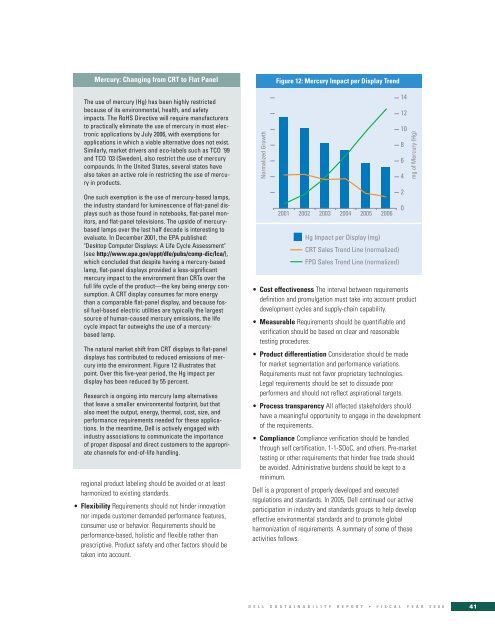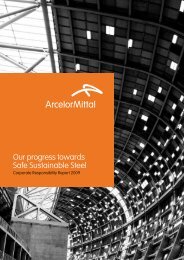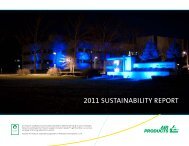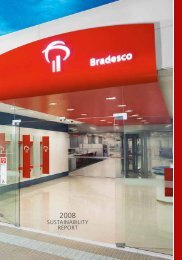Sustainability Report - Dell
Sustainability Report - Dell
Sustainability Report - Dell
Create successful ePaper yourself
Turn your PDF publications into a flip-book with our unique Google optimized e-Paper software.
Mercury: Changing from CRT to Flat PanelThe use of mercury (Hg) has been highly restrictedbecause of its environmental, health, and safetyimpacts. The RoHS Directive will require manufacturersto practically eliminate the use of mercury in most electronicapplications by July 2006, with exemptions forapplications in which a viable alternative does not exist.Similarly, market drivers and eco-labels such as TCO '99and TCO '03 (Sweden), also restrict the use of mercurycompounds. In the United States, several states havealso taken an active role in restricting the use of mercuryin products.One such exemption is the use of mercury-based lamps,the industry standard for luminescence of flat-panel displayssuch as those found in notebooks, flat-panel monitors,and flat-panel televisions. The upside of mercurybasedlamps over the last half decade is interesting toevaluate. In December 2001, the EPA published:"Desktop Computer Displays: A Life Cycle Assessment"(see http://www.epa.gov/oppt/dfe/pubs/comp-dic/lca/),which concluded that despite having a mercury-basedlamp, flat-panel displays provided a less-significantmercury impact to the environment than CRTs over thefull life cycle of the product—the key being energy consumption.A CRT display consumes far more energythan a comparable flat-panel display, and because fossilfuel-based electric utilities are typically the largestsource of human-caused mercury emissions, the lifecycle impact far outweighs the use of a mercurybasedlamp.The natural market shift from CRT displays to flat-paneldisplays has contributed to reduced emissions of mercuryinto the environment. Figure 12 illustrates thatpoint. Over this five-year period, the Hg impact perdisplay has been reduced by 55 percent.Research is ongoing into mercury lamp alternativesthat leave a smaller environmental footprint, but thatalso meet the output, energy, thermal, cost, size, andperformance requirements needed for these applications.In the meantime, <strong>Dell</strong> is actively engaged withindustry associations to communicate the importanceof proper disposal and direct customers to the appropriatechannels for end-of-life handling.regional product labeling should be avoided or at leastharmonized to existing standards.• Flexibility Requirements should not hinder innovationnor impede customer demanded performance features,consumer use or behavior. Requirements should beperformance-based, holistic and flexible rather thanprescriptive. Product safety and other factors should betaken into account.Normalized GrowthFigure 12: Mercury Impact per Display Trend2001 2002 2003 2004 2005 2006Hg Impact per Display (mg)CRT Sales Trend Line (normalized)FPD Sales Trend Line (normalized)• Cost effectiveness The interval between requirementsdefinition and promulgation must take into account productdevelopment cycles and supply-chain capability.• Measurable Requirements should be quantifiable andverification should be based on clear and reasonabletesting procedures.• Product differentiation Consideration should be madefor market segmentation and performance variations.Requirements must not favor proprietary technologies.Legal requirements should be set to dissuade poorperformers and should not reflect aspirational targets.• Process transparency All affected stakeholders shouldhave a meaningful opportunity to engage in the developmentof the requirements.• Compliance Compliance verification should be handledthrough self certification, 1-1-SDoC, and others. Pre-markettesting or other requirements that hinder free trade shouldbe avoided. Administrative burdens should be kept to aminimum.<strong>Dell</strong> is a proponent of properly developed and executedregulations and standards. In 2005, <strong>Dell</strong> continued our activeparticipation in industry and standards groups to help developeffective environmental standards and to promote globalharmonization of requirements. A summary of some of theseactivities follows.14121086420mg of Mercury (Hg)D E L L S U S T A I N A B I L I T Y R E P O R T • F I S C A L Y E A R 2 0 0 641
















